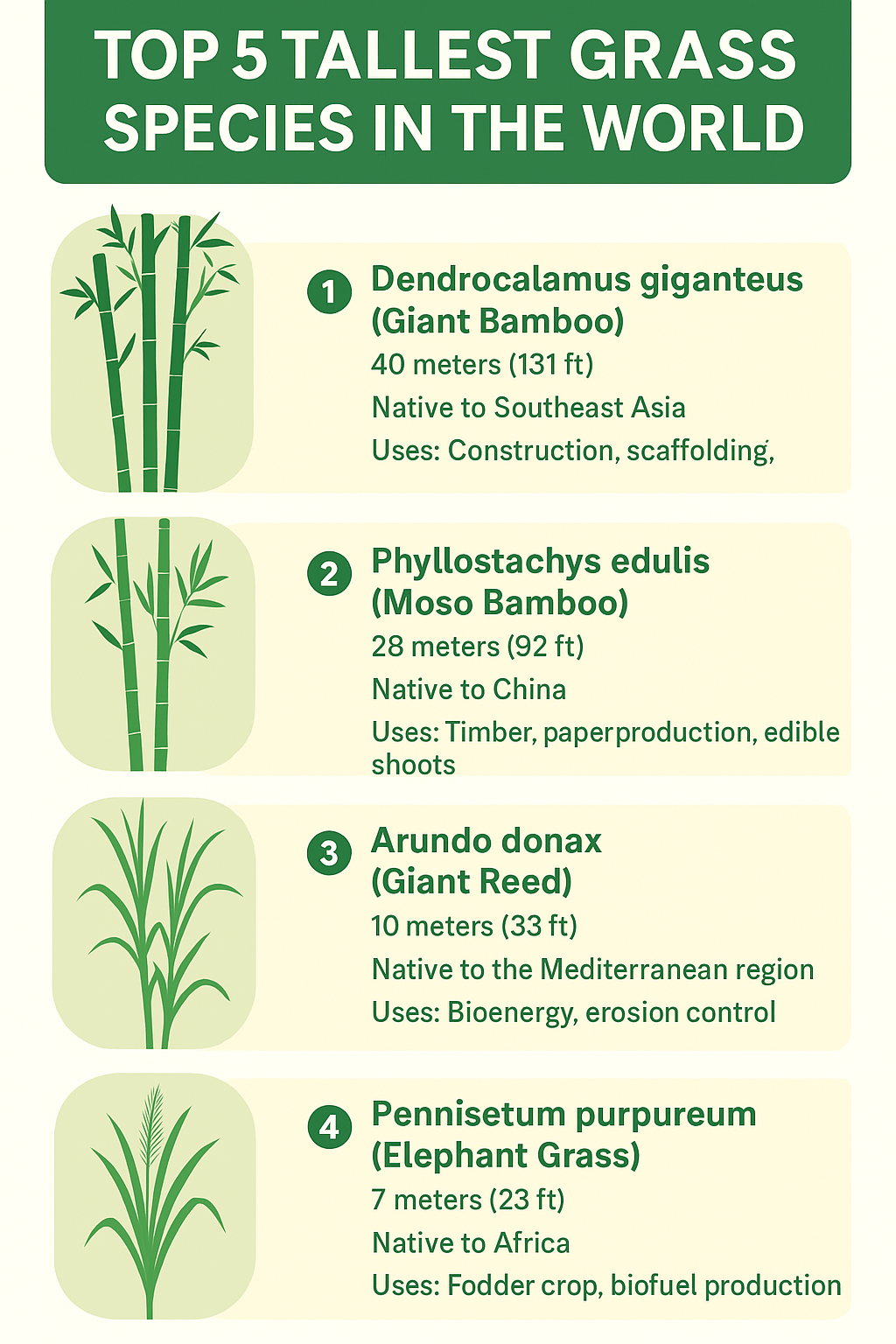Grasses, while seen as ordinary and common plants, can rise to act like small trees. In addition to being impressive vegetation, they can also be important contributors to functional ecosystems, agriculture, and human industry. They are useful for providing a shelter and food for humans and livestock, and they serve as raw material to produce construction materials and bioenergy-based products, as well as have positive ecological and economic value.
There is an incredible wealth of diversity within the grass family of plants adapted to live in tropical, subtropical, and temperate regions of the world. In this article, we will identify seven of the tallest grass species in the world, noting the unique characteristics and height of each, their native regions, and their contributors to practical uses, to share the beauty of the incredible power of nature to bring together strength, resilience, and beauty.
Check Out: List of Top 10 Glowing Plants in the World
Top 7 Tallest Grass Species in the World
Here are the top 7 largest grass species in the world along with their height and their country to which they belong:
| No. | Name | Height | Country / Region |
| 1 | Dendrocalamus giganteus (Giant Bamboo) | 40 m (131 ft) | Southeast Asia |
| 2 | Phyllostachys edulis (Moso Bamboo) | 28 m (92 ft) | China |
| 3 | Arundo donax (Giant Reed) | 10 m (33 ft) | Mediterranean region |
| 4 | Pennisetum purpureum (Elephant Grass) | 7 m (23 ft) | Africa |
| 5 | Saccharum spontaneum (Wild Sugarcane) | 6-7 m (20-23 ft) | South & Southeast Asia |
| 6 | Saccharum officinarum (Sugarcane) | 6 m (20 ft) | Tropical regions (cultivated) |
| 7 | Miscanthus giganteus (Giant Miscanthus) | 4 m (13 ft) | Asia (hybrid, cultivated) |

1. Dendrocalamus giganteus (Giant Bamboo)
Dendrocalamus giganteus is the world's tallest grass species, reaching a height of 40m (131 ft). It is native to Southeast Asia and is well-known for its tall, strong but flexible stems that can be used to manufacture a number of products including scaffolding, construction materials, and furniture. Interestingly, although this species is called "giant bamboo" it differs greatly in size, habitat, and growth form from other giant bamboos like Phyllostachys edulis.
2. Phyllostachys edulis (Moso Bamboo)
Moso bamboo, or Phyllostachys edulis, grows to a height of 28m (92 ft) and is predominantly found eastern China. This species is economically important for constructing homes, producing paper, and harvesting edible bamboo shoots. It is also called "giant bamboo" but is a different species from Dendrocalamus giganteus despite sharing a name. Each species has its own distinct structural characteristics and based on the way each species grows, an individual member of one species may look for all intents and purposes like the other species.
3. Arundo donax (Giant Reed)
Arundo donax (giant reed) can grow up to 10 m (33 feet) tall. Arundo donax is native to the Mediterranean region and is considered a rapidly growing biomass species for bioenergy, erosion control as well as for traditional and historical musical instruments, including flutes, etc. Giant reed is a useful grass species due to its strong woody stems, and can be used for several ecological and industrial purposes.
4. Pennisetum Purpureum (Elephant Grass)
Elephant grass can grow to about six to seven meters (20 to 23 feet). It is a very important fodder for livestock but it is also cultivated for biofuel production. As a tall grass that grows dense, elephant grass has positive utility as ground cover preventing erosion and soil protection. Thus, it can be of value for agriculture and ecological conservation.
5. Saccharum Spontaneum (Wild Sugarcane)
Wild sugarcane, Saccharum spontaneum, grows to a height of 6-7 meters (20-23 feet) and is distributed over South and Southeast Asia. It is a significant plant for soil stabilization along river banks and wetland areas and is considered to be the wild ancestor of cultivated sugarcane species. Its ability to grow rapidly and adapt to different abiotic conditions makes it ecologically important.
Comments
All Comments (0)
Join the conversation